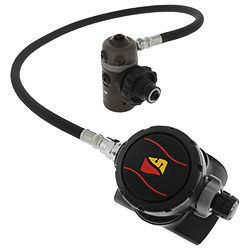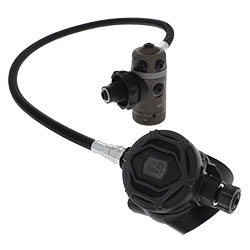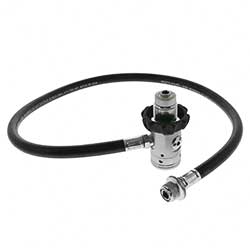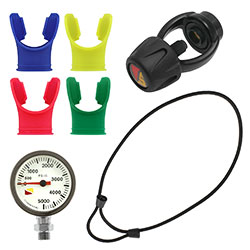Dive Rite XT Regulators
Perfectly configured by Dive Gear Express, there is a regulator setup that meets the needs of everyone seeking Dive Rite® Equipment for Serious Divers™. The DGX Custom versions are fully assembled and integrated by Dive Gear Express using Dive Rite first and second stage regulators together with our premium quality hoses, gauges, adapters, stainless steel hardware and other accessories.
 WARNING
WARNING
Dive Rite does not endorse the installation or substitution of any non-factory part or component with their products because they do not have the ability to control or evaluate the quality and compatibility of such items. The installation of non-factory parts such as regulator hoses or other components may or may not have negative effects upon performance, function and safety. Dive Rite disclaims liability for defect, damage or injury caused by the use of any non-factory parts or accessories.
16 Reg & SPG FAQ
We can build it for you as a special order, but we do not offer octopus setups in our pre-configured regulator packages. The traditional configuration is based on wearing a jacket style BC with analog gauges mounted in a console and donating a 'safe second' to an out-of-air diver. This archaic setup is uncomfortable and at worst unsafe when considering current best practices in recreational diving.
A modern regulator configuration is based on an assumption the diver is wearing a harness & plate with back inflation wing and donating the primary from a long hose in an emergency. The diver uses a wrist mount computer & compass paired with a wireless transmitter to monitor gas pressure (although many divers have a backup analog SPG on a short high-pressure hose clipped to a waist D-ring.) Take a look at our TekTip explaining the Streamlined Open Water Configuration (aka AOW Configuration).
It is difficult to give you a meaningful answer regarding breathing performance of ANY of the primary regulators we sell, including our own DGX Gears brand, in relation to other specific brands or models we don't sell. However, perhaps we can put the performance issue in perspective: In reality, any modern balanced general purpose scuba regulator, designed to perform to EN 250 standards and properly maintained, is capable of delivering gas more than adequate for the needs of two sport divers (primary plus an octo). That's not to say there aren't poorly performing sport regulators in the market, but you can't buy them at Dive Gear Express.
There is no perfect regulator; they all have strengths and weaknesses that make each uniquely more or less suited to your needs. Keep in mind that a big brand name and high price are factors that rarely equate to better performance or better value. When choosing regulators at Dive Gear Express, make your decisions based on considerations that are less about "performance" and more about matching the regulator to the diving application. For example, an extreme exposure (i.e. deep and cold) technical diving regulator is a poor choice for shallow tropical sport diving. Beyond the features of the regulator itself, you should consider the supplier along with how the model was designed and has been supported. As an independent servicing dealer, we stock complete regulator packages, components and parts with online ordering and same day shipping.
With one exception, all the diaphragm regulators we sell are environmentally sealed, including the DGX Gears D6, Dive Rite XT1, Mares 28XR, and Apeks XTX series (DS4, TEK3, DST, FSR) first stages. The Poseidon Xstream is a unique balanced rolling diaphragm ball valve design that is not environmentally sealed because it relies upon a built in thermo-dynamic anti-freeze system to remain ice free.
Piston regulators are not typically described as environmentally sealed in the conventional sense because the internals are protected by other methods inherent in their design. The DGX Gears XTRA & FIRST, Dive Rite RG5400, and Mares R2XR are piston first stages.
The need for sealing a first stage is not relevant to most types of diving, for more information read our TekTip titled Environmentally Sealing SCUBA Regulators.
The manufacturers of all the general purpose SCUBA regulators we stock describe them as suitable for use in warm, temperate and cold water conditions. Based on testing standards we define those water temperature ranges as follows:
- • Warm water is greater than {68°F | 20°C} to a maximum of {90°F | 32°C}.
- • Temperate water is between {68° to 50° F | 20° to 10° C}.
- • Cold water is less than {50°F | 10°C} to a minimum of {40°F | 4°C}.
- • Freezing water conditions below {40°F | 4°C} incurs significant additional risk that requires specialized training and specialized equipment.
Among the regulators we stock, only the Xstream series is described by Poseidon as suitable for diving under ice in freezing seawater conditions down to {29°F | -2°C}. However, the XTX series is a close second, described by Apeks as suitable for use down to {36°F | 2°C} and a popular choice among "ice divers".
Yes, these fittings are very standardized. Technical divers use the DIN connection because it is much more reliable than yoke connection. All SCUBA regulator first stages sold by Dive Gear Express have a universal standard DIN connector (also known as G 5/8" BSP) that will work with any 200 bar and 300 bar DIN outlet SCUBA valve. Internationally, the DIN outlet is by far the most commonly seen type of valve connection. The yoke A-clamp fitting for the K-valve outlet is still predominate in North America and the Caribbean, although even here the universal Pro DIN/K valve is rapidly replacing the K-valve on rental tanks. The DIN outlet is the most travel friendly because for use with K-valves, our DGX Custom sport regulator packages for all brands include an easy DIN-to-Yoke spin on adapter. A DIN-to-Yoke adapter is also available for purchase as a low cost option for those SCUBA regulators that don't include an adapter.
For more information please read our detailed article SCUBA Valves and Regulator Fittings.
Popular for stage/deco/sidemount technical diving applications, the ambidextrous and reversible second stage regulator designs ultimately offer the same feature: the orientation of the hose inlet and thus the hose routing can be either the typical right-hand side or the uncommon left-hand side of the diver. The difference is how this reorientation is accomplished.
In the few second stage designs that are reversable, the regulator body is opened, the inside components are removed, reoriented to the opposite side and the regulator is reassembled. Both the Dive Rite XT series and Apeks XTX series second stages are reversable. The Dive Rite XT series second stages require a mirror image part for the venturi be exchanged to accomplish the reversal. The Apeks XTX series second stages do not require any additional parts for the reversal. Both Dive Rite and Apeks describe the process of reconfiguring the regulator as both quick and simple, however they also both recommend this be done by a regulator technician. It takes our experienced reg tech about 15 minutes to do the reverse and bench test, if you don't interrupt them with any questions.
Ambidextrous second stage designs are inherently right or left when you simply put the regulator in your mouth. The design of the regulator is symmetric about its longitudinal axis; the body and mouthpiece has no "top and bottom" or "up and down". The exhaust on an ambidextrous design will always be on the end the body directly opposite the hose inlet and bubbles come out the end not the bottom. Ambidextrous regulators are typically referred to as side-breathers and we offer the SXS downstream second from Mares plus the Xstream upstream second from the OG of side-breathing regulators - Poseidon.
YES! Dive Gear Express offers regulator service on all models we currently sell. Dive Gear Express is an authorized service center for Apeks, Dive Rite, Mares XR, and Poseidon regulators. We of course also provide service for our house brand DGX Gears regulators. For all the details visit SCUBA Regulator Maintenance Service at Dive Gear Express.
For regulator brands that we are not certified to service, we recommend using a factory authorized service center nearest you. Three long established U.S. based companies that specialize in factory authorized regulator service for most brands are Airtech in North Carolina, RegTech in Wisconsin, and Pacific Scuba Repair in California.
The typical intermediate pressure setting for most first stages is around {135 psi | 9.5 bar}. Upon request a Dive Gear Express service technician will adjust the IP to your specified non-standard setting prior to shipment but only for diaphragm first stage designs. We also offer 3rd party modifications to the Apeks DS4 to change the behavior of the intermediate pressure; enabling use with constant mass flow orifices and needle valves found on some types of rebreathers.
The IP adjustment on diaphragm type first stages is simple enough for most divers to learn to do themselves. The IP adjustment screw is located under the environmental seal cap on the bottom of the regulator. The only tools needed are a round surface spanner wrench to remove the cap, a hex key set to turn the adjustment screw to change the IP setting, and an IP pressure gauge to measure the setting. These are all available in our Regulator Service Tools category. A few minutes with a knowledgeable peer or Google will show you how.
The only difference between our unbranded SPG "brass & glass" models and similar branded SPG models is the logo and price; any SPG will work on any regulator regardless of brand and they are all manufactured by Termo Industra of Italy with equal quality construction. Our unbranded generic SPG models have a lower retail price as a result of being sourced directly from the manufacturer. Our long experience with the unbranded and branded "brass & glass" SPG models has been they all have similar reliability and durability in the field. Regardless of brand, every product we sell is backed by Dive Gear Express 5-star quality customer service. For more information see our TekTips titled SPG Depth Ratings and Inside Submersible Pressure Gauges.
It's probably not the SPG or hose itself that's leaking. All high pressure SCUBA hoses use an air spool with two tiny #003 O-rings to mate the swivel connector on the female hose fitting to the male fitting on the hose or wireless pressure transmitter. If the air spool O-rings are worn, the assembly can also have a slow leak around the swivel. Even when an O-ring has failed completely or the spool is omitted entirely, a tiny flow restriction present in the high pressure port of the regulator and/or the male hose fitting will cause a leak to be much slower than expected. We recommend replacing the air spool, or at least the spool O-rings, whenever replacing the hose. See our video on Leaking SPG Spool Replacement.
No, the sound is completely normal, nothing is loose and nothing is wrong. If you vigorously shake the thin naked gauge, you will hear the sound of the internal coil spring contacting the body.
The sound is typical for all thin gauges regardless of brand, and in no way affects the performance of the gauge. The larger naked gauges, because they have a larger body that allows a different design, do not make this sound. However, g-force impacts on any gauge may cause a loss of calibration so please stop shaking your gauges.
Even when perfectly calibrated in the mid-range, in our experience all analog SCUBA SPGs (including the ones we sell) have poor accuracy at the low end of the scale; possibly indicating significantly more (or less) breathing gas than what is really in the tank.
SPG manufacturers all seem to reference the EN250 SCUBA equipment standards from the European Union for their accuracy specification of these devices; in terms of a percentage, from about ±5% in the middle range to ±10% in the low range of the scale. In contrast, digital pressure gauges built in to air integrated (AI) dive computers are typically accurate to ±1% across their entire range.
Just to be clear, this is not a reflection on the quality of the gauge but rather a limitation of the mechanical Bourdon tube technology when placed into the relatively small case sizes required for SCUBA applications. For details see our TekTip Inside Submersible Pressure Gauges.
The only significant difference is the branding and price; any DIN-to-Yoke adapter will reliably work on any DIN regulator regardless of brand. The designs differ a little but they are all of equal quality chromed brass construction. The generic value priced DGX adapters are available in your choice of black or silver color, and features a nice sized handwheel which makes it easy-grip to install and remove from the valve.
Omniswivel brand products are available with a exceptional variety of different fittings and most are made from marine grade stainless steel. The Omniswivel brand itself is well known† for their product quality and their products are made in the USA. Popular simple adapters are also available in generic chromed brass versions that are manufactured offshore. In our experience the durability and reliability are similar for both Omniswivel brand and unbranded generic versions.
† Originally named M&J Engineering, the company rebranded as Omniswivel International after their most well known product the Omni-Swivel omni-directional 360° swivel adapter that screws in-line between the low pressure hose and any standard second stage.



